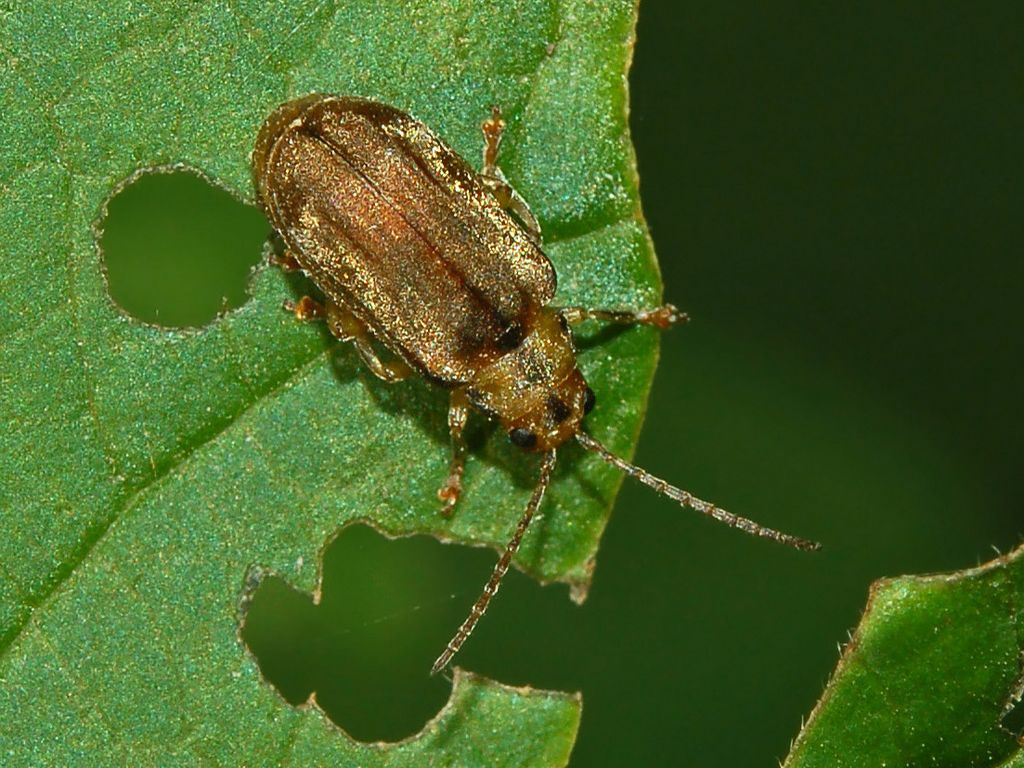Viburnum leaf beetle (Pyrrhalta viburniI) is an insect that feeds on the foliage of viburnum plants. The beetle is native to Europe and Asia. It was first identified in North America in 1947 in Ontario, Canada. The larval and adult stages of the insect are voracious feeders. Dense populations can rapidly defoliate entire plants. Repeated defoliations may result in plant mortality.
Distribution & Habitat
Viburnum leaf beetle is widespread across Europe, Asia, and North America. In the United States, infestations occur throughout many Northeastern, Central, and Southern states. The beetle is particularly abundant in Maine, Massachusetts, New York, Ohio, Pennsylvania, Vermont, and Washington. In Canada, the insect has been reported from Ontario to British Columbia, and across the Canadian Maritime Provinces.
Hosts
Viburnum leaf beetle infests viburnum plants. The most susceptible varieties are American cranberrybush, arrowwood, European cranberrybush, Chinese, Taiwanese, Rafinesque, Sargent, and Wright viburnum, mapleleaf, nannyberry, rusty blackhaw, smooth witherod, and wayfaringtree.
Description
Adult beetles range between 4.5 and 6.5 mm in length. The head, thorax, and elytra of the beetle is yellowish brown to light brown. The anterior edge of the elytra is a slightly darker shade of brown. The beetle’s dorsal surface is laden with thick golden-grey hairs. The eggs produced by the insect measure around 0.4 mm wide. They are rounded, and colored dark yellow to brown. Newly hatched larvae are greenish-yellow, with a glossy sheen. Small black lines form along the center of the body. Alternating black spots appear on either side of the body. The larvae initially grow 1 to 2 mm long. When mature, they may extend 6 to 9 mm in length.
Life Cycle
Viburnum leaf beetle produces one generation per year. The eggs overwinter, and begin to hatch in spring, revealing masses of tiny larvae. The larvae congregate together to feed. They commence feeding on the underside of young, expanding leaves. When larval populations are dense, viburnums may be defoliated within a few days to a few weeks. The larvae progress through three instars, molting between each stage. In early to mid June, the larvae descend from the host, and pupate in the soil. Ten days later, adults emerge from the soil. The adults ascend the host once again, and resume feeding. During this period, the adults mate. The males expire shortly thereafter.
From summer to late fall, the females deposit up to 500 eggs in laying sites that they have prepared on viburnum twigs. The females create laying sites by excavating cavities in the current year’s growth. Once the laying sites have been established, the females deposit around 8 eggs in each hole. The females then seal each hole with a lid composed of chewed bark and excrement. The females continue to navigate up the twig or branch, creating laying sites, and depositing eggs. Egg laying typically occurs during the evening hours.
Symptoms of Infestation
Branches or twigs that are infested with eggs are most apparent in winter, when viburnums have shed their leaves. The larvae and adults tend to concentrate their feeding on the lower leaf surface, between the midrib and the larger veins. The persistent feeding causes the skeletonization of the leaves. Severe infestations can rapidly defoliate plants. Weakened plants may eventually succumb to infestation.
Management
- When planting, select varieties that exhibit an increased resistance to viburnum leaf beetle. Some of the most notable examples include burkwood, carlcephalum, David, dawn, doublefile, Japanese, Judd, Koreanspice, lantanaphyllum, leatherleaf, Siebold, and tea viburnum.
- From late winter to early spring, inspect the twigs and branches of viburnums for egg sites. In late spring, monitor the lower leaf surface for the presence of larvae.
- Prune out and dispose of twigs and branches that are infested with eggs.
- Several natural predators feed on the larvae, including lady beetle adults and larvae, lacewing larvae, and spined soldier bug nymphs. Lady beetle adults and spined soldier bug adults also prey on the insect.
- An adhesive barrier may be placed around the base of susceptible viburnums to prevent the larvae from entering the soil to pupate. Avoid placing sticky materials directly on the bark, as some may have phytotoxic effects.
- Several insecticides are registered for use in controlling viburnum leaf beetle. Applications should be performed in late spring, when the larvae first hatch.
- Horticultural oil can be sprayed on to egg laying sites prior to leaf expansion. The oil will smother the eggs, and prevent them from hatching.
Photo courtesy of Ettore Balocchi CC-by-3.0


